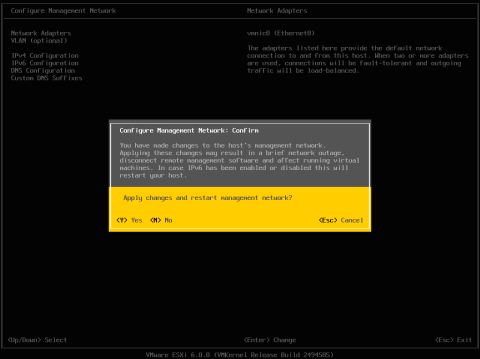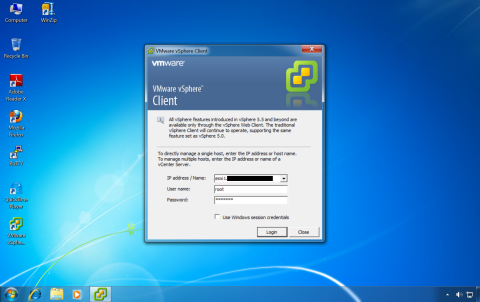Setting up ESXi 6.0 on a 2012 Mac Mini Server
Something I’ve been doing for a while is running ESXi on my home server setup. Up until now I’ve been running ESXi 5.5.x on a 2011 Mac Mini, but with the release of ESXi 6.0 by VMware, I decided it was time to upgrade to new hardware. I opted to use the 2012 Mac Mini Server over the 2014 Mac Mini because the 2012 Mini Server uses quad-core processors with hyper-threading. Hyper-threading effectively doubles the number of available processors, so I would be upgrading from four available processors on my 2011 Mini to eight available processors on my 2012; in turn doubling the number of virtual machines which I could host and run inside of ESXi.
Unlike my previous installation of ESXi 5.x on a 2011 Mac Mini Server, where I needed to add ethernet drivers to the stock ESXi 5.x installer, ESXi 6.0 will install and work without additional drivers or installer modification needed. All I needed to do was download a copy of the ESXi 6.0 installer ISO file from the VMware website, use Disk Utility to burn the ISO file to a CD and use that to install ESXi 6. For more details, see below the jump.
Installing ESXi 6.0 on the Mini
Once I had the CD, I hooked up an Apple USB SuperDrive to the Mini, popped the newly-burned CD in and rebooted the Mini. When rebooting, I held down the Option key on my keyboard to allow the various boot drive options to appear, then selected the CD. The CD showed up with EFI Boot and Windows partitions, so I selected EFI Boot.
NOTE: All screenshots of this process are from ESXi running inside of VMWare Fusion, but the Mac Mini install process was identical.
Once booted from the CD, I was asked to select the ESXi 6.0 installer. Once selected, the ESXi installer boot process began.
1. When asked to begin the installation process, I hit the Enter key.
2. I hit the F11 key to accept the license agreement.
At this point, the installer took a few minutes to scan the machine.
3. Once scanning completed, I was asked to select the drive I wanted to install on. I selected the drive I wanted and hit the Enter key.
4. I selected US Default for the keyboard layout.
5. When prompted, I set a password for the root account. This is the user account that you’ll initially use to log into your ESXi server.
At this point, the installer took a few minutes to scan the machine again.
6. The installer then confirms that you want to install using the options you’ve selected. You’re also warned that the disk will be repartitioned.
NOTE: Repartitioning will wipe everything on the drive. If you have data you need to get off of this drive, hit the Escape key to back out at this point.
7. ESXi 6.0 will then install.
8. When finished, the installer will request that you remove the installation disc and then reboot. Once you’ve removed it, hit the Enter key to reboot.
Booting ESXi 6.0 on the Mini and changing network settings
On reboot, the Mini should now boot from the newly-created ESXi boot drive. Once up at the server display screen, you should see that it’s picked up a dynamic IP from your DHCP server and has the hostname of localhost. Here’s how to change that to a static IP and a new hostname.
1. Click the F2 key.
2. Log in as the root account, using the password you set during the install process.
3. You should be now at the System Customization screen. Select Configure Management Network.
4. In the Configure Management Network screen, select IPv4 Configuration.
5. In the IPv4 Configuration settings, Select Set static IP address and network configuration: and hit the space bar to make that option active.
6. Set the static IP, subnet mask and gateway address. Once finished, hit the Enter key to save the changes.
7. In the Configure Management Network screen, select DNS Configuration.
8. In the DNS Configuration settings, set the address(es) of your DNS server(s) and also set your desired hostname. In my case, I set a fully qualified DNS name.
Once finished, hit the Enter key to save the changes.
9. In the Configure Management Network screen, select Custom DNS Suffixes.
10. In the Custom DNS Suffixes settings, you may need to set a DNS suffix. In my case, my domain was already filled in. Once finished, hit the Enter key to save the changes.
11. Once you’ve made all of your changes, hit the Escape key to exit back to the System Customization screen. You’ll be asked to confirm the changes you’ve made to your network settings and warned that there will be a brief network outage for the ESXi server and any VMs running on it. Hit the Y key to apply the new settings.
12. At the System Customization screen, you should now see your static IP and hostname displayed under Configure Management Network.
13. Hit the Escape key to exit to the server display screen. It should now be displaying your hostname and your static IP address.
Logging to your ESXi server
To log into your ESXi server, I recommend having access to a Windows VM or a Windows PC and running the Windows vSphere client for initial setup. Once you’ve got it up and running, VMware Fusion Pro has a number of ESXi management options.
1. Install the vSphere client on the Windows box.
2. Launch the vSphere client and enter the following information:
IP Address / Name: IP or DNS address of your ESXi server
User name: root
Password: the password you set during the install process
3. You’ll be warned that an untrusted SSL certificate is installed. Click the Ignore button.
If everything worked right, at this point you should be in! You’ll be warned that you’re using a 60 day evaluation license. If you have a VMWare account, you can log in to the VMWare website and download a free ESXi license to use with your Mini ESXi server.




























Thanks a lot for your post.
I can run two Maverick’s clients and one windows 2012 essential server on ESXi 6.0.0.
But I occurred some problems with the video card. I’m unable to change the resolution (fixed at 1024×768). I tried to change it on vSphere Client (many settings) but nothing happened.
This problem is the same for the tree VMs.
Any idea ?
Thanks for your help and support
@Patrick I know this answer is late, but for the rest of you googlers, here is directions on changing your resolution
http://www.virtuallyghetto.com/2015/10/heads-up-workaround-for-changing-mac-os-x-vm-display-resolution-in-vsphere-fusion.html
Have you found a way to control the FAN speed via SMC? My mini 2012 with ESXi 6 (8 vms, 10% total machine usage) is frying here !
Thanks for the great article! Did you ever figure out how to control the fan? Would like to install ESXI but don’t want to fry my Mac Mini!
Hi, anyone got a solution for the temperature / fan speed?
one year without this solution…
Copying contents of ISO to USB (ExFAT) works too.
Very useful article, thanks for taking the time to post it.
has anyone tried to install on a 2TB SSD?
@Justin Weathersbe You should’nt be installing ESXi to your local hard drives. You should dedicate a USB for booting and use the entire 2tb ssd for your datastore
@Patrick I know this answer is late, but for the rest of you googlers, here is directions on changing your resolution
http://www.virtuallyghetto.com/2015/10/heads-up-workaround-for-changing-mac-os-x-vm-display-resolution-in-vsphere-fusion.html
How to access Thunderbolt-connected storage (Pegasus R6)?
I’d love to know if this is possible too!
where you able to get thunderbolt storage to pass through. I have a drobo 5D that i’d like to use with a Mac OSX 10.12 VM
my mac mini fan is full speed , is there any way to slow it down ? i have esxi 6
mine has NO speed, what you did to make this run at full speed?